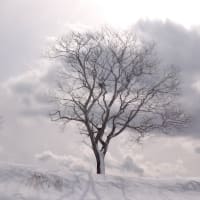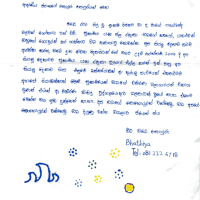We Japanese use several letters. Main words are expressed by Kanji letters imported from China and they are connected by hiragana made by ourselves. Kanji expresses meaning while hiragana expresses sounds as alphabets. In kanji, a tree, for example, is written as below. Of course, this came from the shape of a tree. A wood expressed by two trees, and forest is by three trees.
Each tree species are usually expressed by two letters of tree plus some others. The word oak was mistranslated into "kashi" (evergreen oak) that is written "tree + hard" meaning a (physically) hard tree. The image of kashi is strength and calmness. It is better to translate oak into nara (deciduous oaks), and nara is written "tree + leader". I am not sure why this combination was adopted, but it may mean an oak is not a follower but a leader. If this is correct, old people had image that an oak is different from other less impressive trees. One oak (Quercus acutissim) is written by kanji as tree + joy (pleasure). I think it makes sense. The impression of oak trees may be strong but joyful or light.
Kanji letters nicely express the nature of things.
木
tree
林
wood
森
forest
樫
live oak (evergreen oak): tree + hard
楢
oak in general: tree + leader
櫟
oak (Quercus acutissima): tree + joy
欧州楢
European oak (Quercus robur) presented by Pedro Carvalho
欅
Zelkova serrata in general: tree + raise hands. The tree shape of Zelkova tree looks like a person raises his/her both hands up.
槻
tall tree ofZelkova serrata: tree + rule. The author's name Takatsuki means tall (taka) Zelkova (tsuki)
樅
fir: tree + vertical
松
pine: tree + public
梅
plum: tree + every
杉
cedar: tree + three(?) or shows branch-shape
菩提樹
linden (Tilia): too difficult to explain for me ut it relates to Buddhism. The leaf looks like that of a fig (Ficus religiosa) under which Buddha realized, and old Japanese confused them (Takatsuki)
榛
elm: tree + peace
枯
death of tree or wither: tree + old
Each tree species are usually expressed by two letters of tree plus some others. The word oak was mistranslated into "kashi" (evergreen oak) that is written "tree + hard" meaning a (physically) hard tree. The image of kashi is strength and calmness. It is better to translate oak into nara (deciduous oaks), and nara is written "tree + leader". I am not sure why this combination was adopted, but it may mean an oak is not a follower but a leader. If this is correct, old people had image that an oak is different from other less impressive trees. One oak (Quercus acutissim) is written by kanji as tree + joy (pleasure). I think it makes sense. The impression of oak trees may be strong but joyful or light.
Kanji letters nicely express the nature of things.
木
tree
林
wood
森
forest
樫
live oak (evergreen oak): tree + hard
楢
oak in general: tree + leader
櫟
oak (Quercus acutissima): tree + joy
欧州楢
European oak (Quercus robur) presented by Pedro Carvalho
欅
Zelkova serrata in general: tree + raise hands. The tree shape of Zelkova tree looks like a person raises his/her both hands up.
槻
tall tree ofZelkova serrata: tree + rule. The author's name Takatsuki means tall (taka) Zelkova (tsuki)
樅
fir: tree + vertical
松
pine: tree + public
梅
plum: tree + every
杉
cedar: tree + three(?) or shows branch-shape
菩提樹
linden (Tilia): too difficult to explain for me ut it relates to Buddhism. The leaf looks like that of a fig (Ficus religiosa) under which Buddha realized, and old Japanese confused them (Takatsuki)
榛
elm: tree + peace
枯
death of tree or wither: tree + old



















